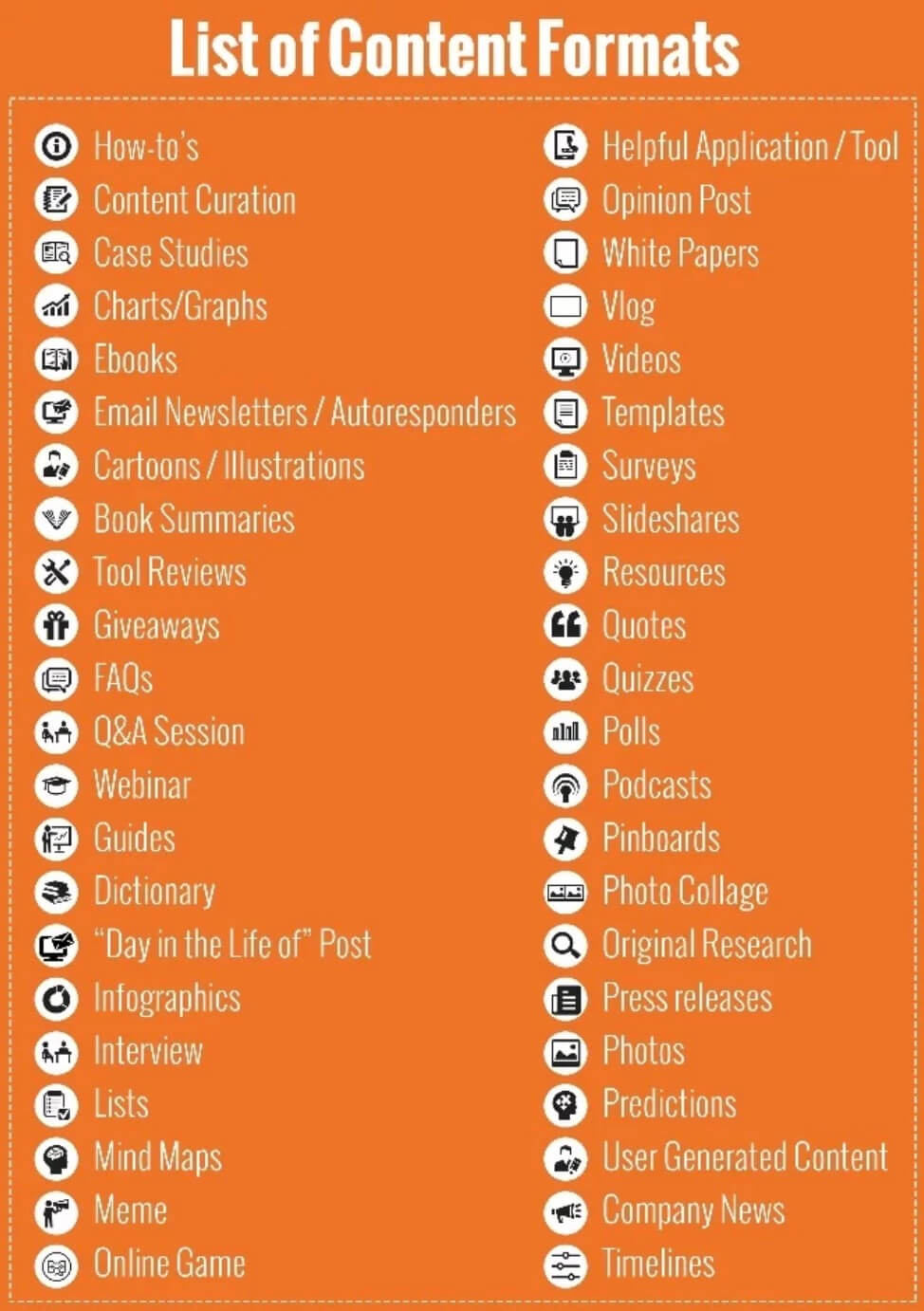Does your website attract few visitors or do you spend a lot of money on advertising every month? Then it’s probably time that you started investing (more) in creating good content. How? Not by just writing texts for your website. Online success requires a strategic approach: content that meets the needs of the visitors. In this blog post, we will show you how to create such a content strategy for the web.
What is a content strategy?
A content strategy (or content marketing strategy) is related to the marketing strategy, but then purely and simply focused on creating and sharing content. Because this is very broad, different forms of marketing can also fall under content marketing. Think for example of e-mail marketing, social media marketing, and search engine marketing.
Our definition:
A plan of approach for creating different forms of content to attract more visitors to your website, generate more sales and attract more customers to your brand.
The advantages of a strong content strategy
Of course, you don’t make a content strategy without a reason. These are the advantages that a good content strategy can offer:
- Ensures that all content forms a whole. Every piece of content that you create has to support a different piece of content. In the long run, this amount of information ensures that your website is seen as an authority by Google.
- Empowers the systematic growth of your website. A website that is regularly updated with new and good content creates new visitors and more opportunities to score high in Google.
- It helps you to better represent the interests of your visitors. Content that is valuable to the visitor delivers more than content that is about your company, services or products.
- The content delivers the desired results. A large part of the content created by companies is either not findable or does not yield enough conversions. With a strategy you increase the effect of the content you create.
- It makes it easier to sustain the creation. Do you want to benefit from the advantages of content marketing? Then it’s important that you don’t stop your efforts after 1 month. With a good strategy you will make sure that you can go on for months to come!
Set up a content strategy step by step
A good content strategy consists of the following components: a description of the goals, the positioning, the target group, the content channels/forms, the frequency and the procedures for placing the content.
What are your goals?
Content marketing can bring benefits for the findability of your website in Google, your brand awareness or your relationship with existing and new customers. Clear goals are needed to be able to test whether your efforts are producing the desired results. Examples of goals are:
- Increasing the findability of your website
- Attract more visitors to your website
- Build brand authority
- Strengthening the relationship with the customer
- Reduce customer service efforts
- Increase the number of leads
- Improving the customer experience
- Become a Thought leader
- Transferring certain knowledge to the target group
- Convincing people of a particular point of view
The trick is to formulate your goals in such a way that they are specific, measurable, acceptable, realistic and time-bound (SMART). For some goals, this will be easier than for others. For example, it is less easy to test whether your content marketing efforts improve the customer experience or make you a thought leader. However, you can easily solve this problem by making a distinction between your short-term goals and your ambitious long-term goals. The latter is actually the reason why you start with content marketing.

The impact of Content Creation on SEO
Positioning
Before you start creating content, it’s good to know who your competitors are and what they do in terms of content marketing.
On which channels are they present? What kind of content do they create? On what keywords are they found? What is the tone of voice? And how often do they post? The purpose of answering these kinds of questions is actually to find out whether there is still room for an extra player in the market. A competition analysis, therefore, helps you to find your distinctive character. By determining what your strengths and weaknesses are and what opportunities and threats are present, you research which positioning works for your content marketing strategy.
Target group
If you try to reach everyone with your content, there is a good chance that you will not reach anyone. But who are you making all that content for? For the people who are interested in buying your product? Not only that! Of course, your potential customers belong to the target group, but the main goal of content marketing is not to sell your products or services. For example, do you want to increase your brand awareness and/or the chance that visitors will become potential customers in the future? Then it is important to choose a broader target group than your current potential customer.
Then you want to know about your target group:
- What problems do they have that you can solve?
- What do they want?
- On which channels are they present?
- What keywords do they use?
- What other companies/influencers do they follow?
Content channels/shapes
The next step is to determine what kind of content you are going to create and where you are going to distribute it. Of course, this depends on the problems of the target group and the channels they use, but also on the possibilities you have.
Examples of channels are:
- Social media
- Newsletter
- Website
- Third-Party Websites
- Youtube
If you look at the shapes, you can see in the picture below that there are a lot of possibilities. In addition to blog posts, ebooks, videos, and social media messages, content marketing also includes case studies, manuals, events, webinars, and competitions.

In the content strategy, you set out which forms you are going to use, what the goal is and during which phase of the customer journey you are going to use the content.
Content creation frequency
If you want to benefit as much as possible from your efforts, it is necessary to continue to make and share consistency. But how do you determine how often you will place something? Don’t place too much or too little. Potential customers shouldn’t mind receiving your messages. Of course, they shouldn’t forget you because you don’t share enough content. Consistency is more important than frequency. If you first follow a clear schedule and then post content whenever you want, your loyal followers will disappoint. Also, take into account the timing of placing the content. It is often difficult to estimate when the best time to share the content is. It’s better to wait for the posting if you think that people will be less active online at a certain point in time.
Publication procedures
Do several people within your organization work on creating and publishing the content? Then it is even more important to work out in the content marketing strategy how the content should be placed. But even if you create and place all the content on your own, it is useful to have a small manual that you can fall back on. For the publication procedures, it is useful if these are clear. Every content creator must be able to place the content in the right way without the help of someone else.
In the publication procedures, for example, you can specify each channel:
- How large the images should be
- Whether particularities may/must be added to the images
- Which colors/fonts can be used
- How long certain texts can be (e.g. the intro)
- An example of what the end result looks like
- How content should be placed differs per channel, of course. Therefore, work out the publication procedures for each channel!
How do you use the content marketing strategy?
It’s good to know how to make a content strategy, but making a content strategy is not enough. Of course, you also have to do something with it. But how? When you have developed a good content marketing strategy, this is actually the thread that runs through your content marketing efforts. The strategy tells you:
- Who you are going to make the content for
- What kind of content you are going to create
- On which keywords you want to be found
- How the content should be placed
- And what results your efforts should yield.
- Based on the strategy you can make a concrete plan, a content plan (or content calendar).
What is a content plan?
In a content plan, you collect all the pieces of content that you are going to make, for example, for the next 3 months. For each piece of content, for example, you specify:
- What the content becomes
- For which channel you are going to create the content
- To which phase of the customer journey it belongs
- What the specific purpose of the content is
- Who the target group is
- For which keyword the content is written (only for blog posts and web pages)
- When you’re going to post the content
Unlike the content strategy, a content plan changes continuously. Is all content created and published? Then you make a new plan for the coming period. A content marketing strategy can only be changed if you have achieved the goals, if your goals have changed in the meantime or if your current strategy does not succeed in achieving the goals.
Assessing the success of your content marketing strategy
A content marketing strategy is not only a guideline but also a means of checking whether your efforts have produced the desired result. That’s how you want to know after a while:
- Which content gets the most attention
- How to score your blog posts in the search engine
- Which content will cause you to get more registrations or followers?
- Which content is shared the most
- Which conversions work best
By assessing the success of your content marketing strategy, you know whether your goals have been achieved or what else you can do to achieve them.
What if you have already started without a content strategy?
If you had already started creating content for your company, then you already have some results to analyze before you start with your content marketing strategy. Make sure you make use of this. Setting up a strategy is much easier with this input. Of course, we have a few tips on how you can best use this input for your content strategy:
- Have you written a few blog posts, but haven’t done any keyword research in advance? Use the information in Google Search Console to check which keywords your blog post is already found on. This allows you to determine whether the keyword should only be added to the blog post more often, but it can also happen that the article in this form actually has no chance of scoring at all.
- Do you find it difficult to determine what kind of content you should create? Then take a look at which content you’ve created gets the most attention from visitors and followers. You want to create this kind of content more often in the future.
- Have you already added different types of conversion elements to your content? Then you also know which conversion elements work better than others. With this information, you can better determine what realistic goals are and how you can achieve these goals.
- Use the feedback from your visitors for your content strategy. Have you already received reactions to your content from (potential) customers? Be sure to use this information for your content strategy.
- If you have already created content, then you can already know where visitors drop out.
- Do visitors spend little time on a page or do they often leave the website on a particular page? This kind of information can help you to set up an even better content strategy!
FML Marketing – Content Marketing Specialist Costa del Sol
If you want more online success with your website, we advise you to create content according to a well-thought-out content marketing strategy. Small businesses, in particular, can use a content strategy to reach a larger audience and thus grow their organization.
Would you like to know more about setting up a content marketing strategy? We can guide you in setting up a content strategy. Of course, we can also develop a complete strategy for your website!


